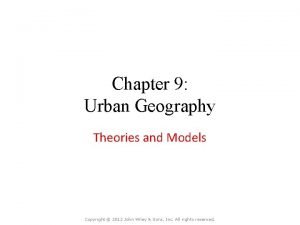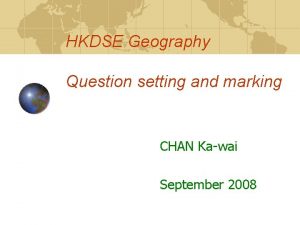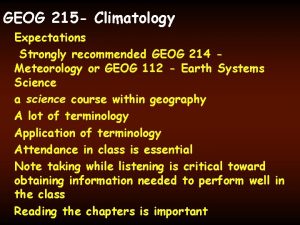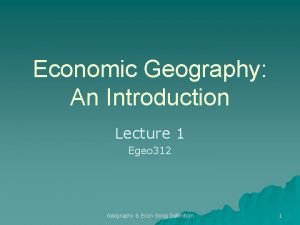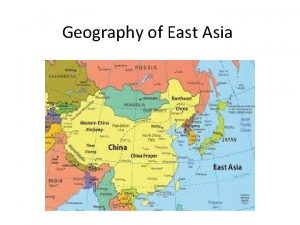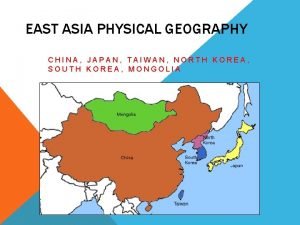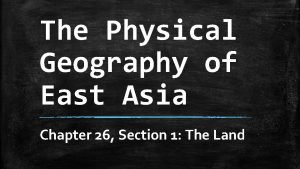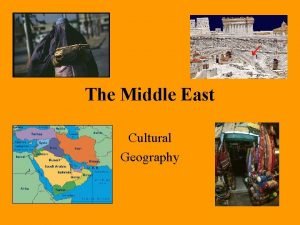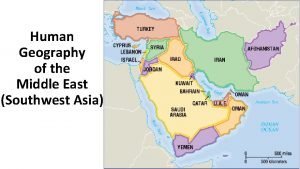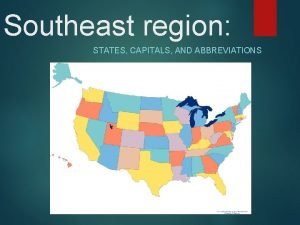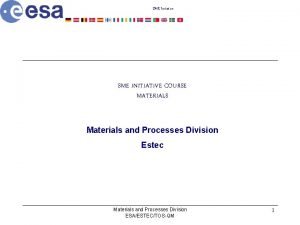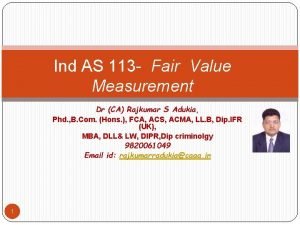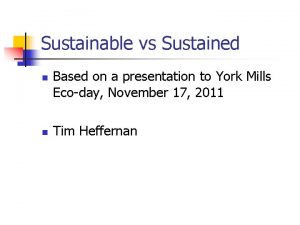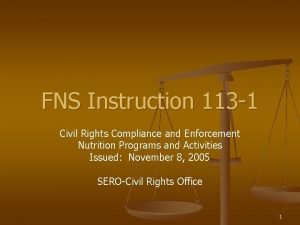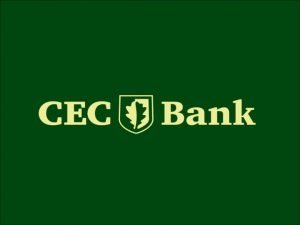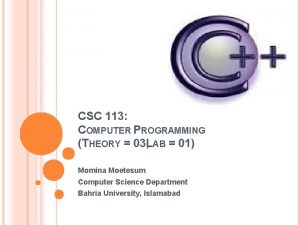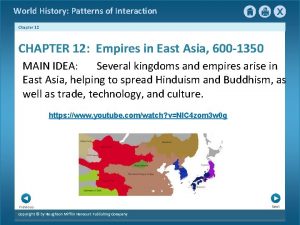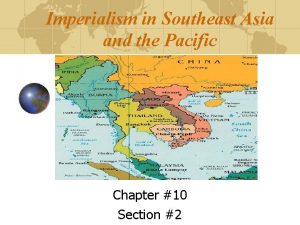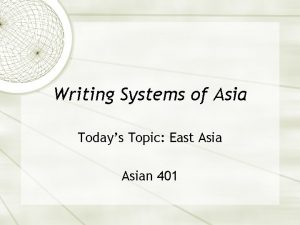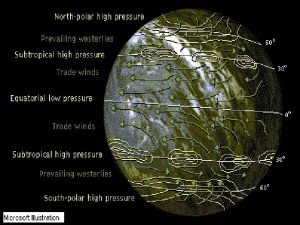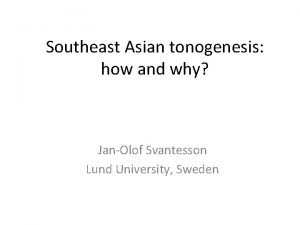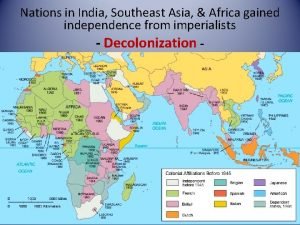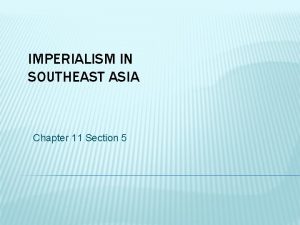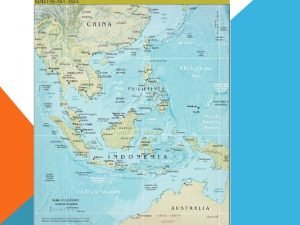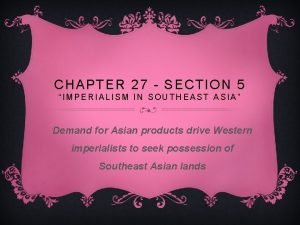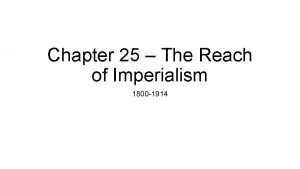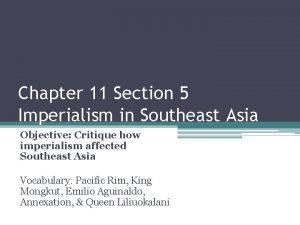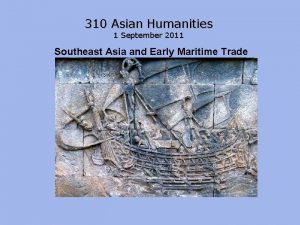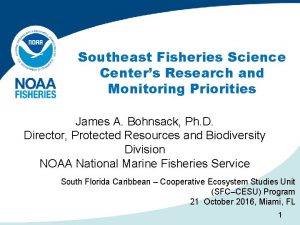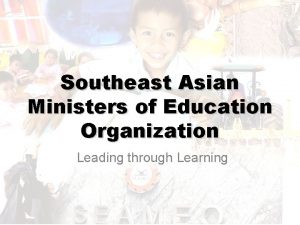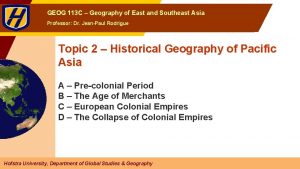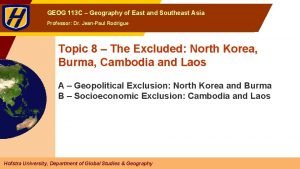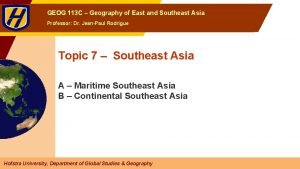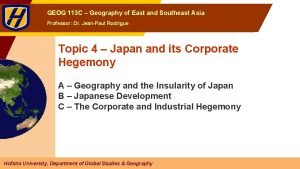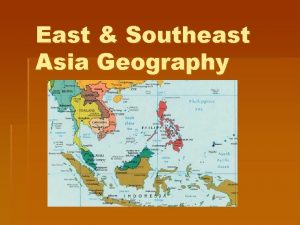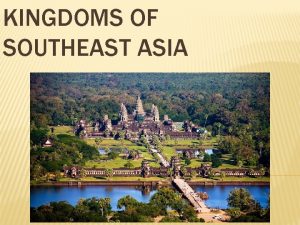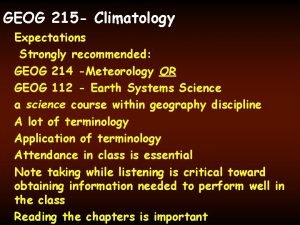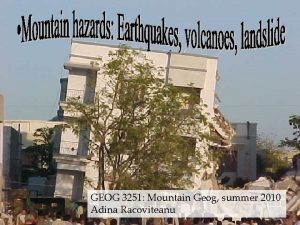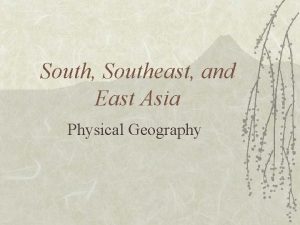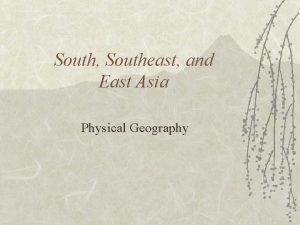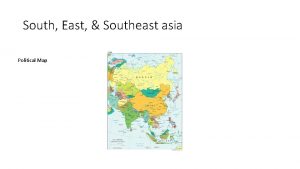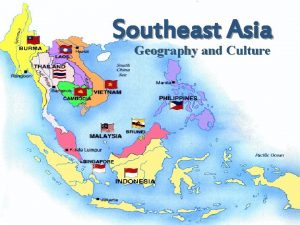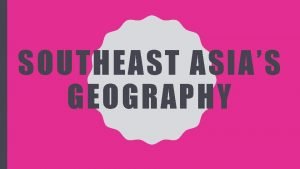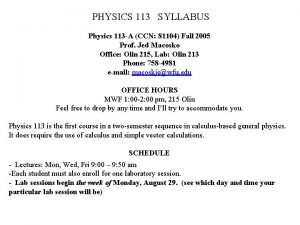GEOG 113 C Geography of East and Southeast








































































- Slides: 72

GEOG 113 C – Geography of East and Southeast Asia Professor: Dr. Jean-Paul Rodrigue Topic 6 – The East Asian Tigers: Hong Kong, Taiwan and South Korea A – Hong Kong: China’s Gateway B – The Other China: Taiwan C – South Korea: A Divided Country Hofstra University, Department of Global Studies & Geography

The East Asian Tigers ■ What the Tigers have in common? South Korea Taiwan Hong Kong • • • Small sized with small populations. Little or no natural resources. Market economies / trade gateways. Democracies / Semi-democracies. Coastal / Maritime access. Chinese dominance (except South Korea; cultural influence). Singapore © Dr. Jean-Paul Rodrig

A. HONG KONG: CHINA’S GATEWAY 1. Geographical and Historical Context What is specific about the geography of Hong Kong? Why the location of Hong Kong is so important? What is the status of Hong Kong within China? 2. South China’s Hub To what extent trade is linked to the dynamism of Hong Kong? What are the major economic functions of Hong Kong? 3. Urban Planning in Hong Kong How urban planning has adapted to the unique context of Hong Kong? © Dr. Jean-Paul Rodrig

1. Geographical and Historical Context: Scarcity Issues in Hong Kong Limited Land About 1, 108 square kilometers (400 square miles): 200 islands. Only 100 square kilometers can be used: 9% of the territory. Geography is a multiplying constraint. High Densities The island of Hong Kong, which includes the CBD. Kowloon, the continental peninsula. About 5, 900 persons per square kilometers, but the real numbers are about 59, 000. Some parts have a density of 250, 000 persons per square km (Manhattan has about 33, 000). Expansion The territory is expanding due to land reclamations. 10% of the developed land. Gained about 6 square kms (1997 -2004). Additional 7 square kms (2005 -2015) Geographical context Head of the Pear River Delta. Vulnerability to Monsoons and typhoons (hurricanes; June to August). Rain induced landslides a risk. © Dr. Jean-Paul Rodrig

Main Territorial Elements of Hong Kong China (Shenzhen) New Territories Port Airport Kowloon CBD Hong Kong Island © Dr. Jean-Paul Rodrig

1. Geographical and Historical Context ■ Immigration • • • Population of 7. 4 million (2018). About half the population was born in Hong Kong. The great majority of the population comes from southern China. 95% of Chinese ethnic origin. Indian and European (expats) minorities. Cantonese the main language, with Mandarin growing rapidly since 1997. ■ Global connections • • A global city. A cosmopolitan population (British colony from 1842 to 1997). A financial center. A first-rate port and airport (new): • Linked to international trade. © Dr. Jean-Paul Rodrig

6 19 0 62 19 64 19 6 68 19 70 19 7 19 2 7 19 4 76 19 78 19 0 82 19 84 19 8 19 6 88 19 90 19 9 19 2 9 19 4 96 19 98 20 0 02 20 04 20 0 20 6 0 20 8 10 20 1 20 2 1 20 4 16 20 18 19 Millions Population of Hong Kong, 1960 -2018 8 Retrocession to China 7 China’s Open-Door Policy 6 5 4 3 2 1 0 © Dr. Jean-Paul Rodrig

1. Geographical and Historical Context ■ Cost of living • One of the most expensive place in the world. • No income, sales or capital gain taxes. • Massive intervention of the government in housing: • Most of the population cannot afford private housing. • 95% of the population lives in apartments. • 49% of the population lived in public or subsidized housing in 2018. ■ Resources of Hong Kong • Hong Kong has no natural resources to speak of. • Strategic location for the China trade. • Its natural harbor is its most important resource: • Deep water port. • 5 th largest container port in the world (after Singapore and Shanghai). • Highly integrated in the transpacific trade. © Dr. Jean-Paul Rodrig

1. Geographical and Historical Context ■ Colonial history and a regional paradox • Linked with the British Colonial history in Pacific Asia: • “Borrowed place living on borrowed time”. • More than 150 years of British occupation. • Contradiction with the surrounding environment: • One of the most liberal market economy next to one of the most hard-liner communist nation. • 7 million people compared to 1. 3 billion. © Dr. Jean-Paul Rodrig

The Foundation of Hong Kong Event Consequences Foundation (1821) Hong Kong island was occupied by opium dealers; Operation base for the opium trafficking in China. Opium War (1839 -1842) China forbade opium traffic in 1839. British forces retaliated and won a settlement with China. Treaty of Nankin (1842) Opened five Treaty Ports along the Chinese coast. Ceded the island of Hong Kong to England in perpetuity. 6, 000 inhabitants lived in Hong Kong. Treaty of Tiensin, second Opium War, (1860) Acknowledged the ownership of Kowloon by England. Bail of 1898 Bail of 99 years for the New Territories was signed, which expired June 30 th 1997. Provided an agricultural hinterland for Hong Kong © Dr. Jean-Paul Rodrig

1. Geographical and Historical Context ■ Emergence of an entrepot • Interface function with Southern China. • Opium trade was gradually abandoned: • More “noble” activities appeared in Hong Kong. • Finance, banks and insurance companies. • No tariffs on trade applied by the colonial government. • Political instability in China: • • End of the Qing dynasty (1911). Favored the immigration of Chinese merchants. Kept their business network with China. Provided new trade opportunities for Hong Kong. • Transplantation of the Chinese merchant and business class to Hong Kong. © Dr. Jean-Paul Rodrig

War and Crisis in Hong Kong Event Consequences Japanese invasion of Manchuria (1937) Collapse of the Chinese central government. Most of the coastal regions occupied (1938), including Guangdong province next to Hong Kong. Japanese occupation (19411945) End of Hong Kong’s commercial role. Massive deportations (about 150, 000 people). Chinese Civil War (1945 -1949) Increased influx of refugees from mainland China. 750, 000 between 1945 and 1949. 500, 000 between 1949 and 1950. Korean War (1950) Trade with China halted. UN embargo and communist / isolationist China. Loss of the commercial hinterland. © Dr. Jean-Paul Rodrig

1. Geographical and Historical Context ■ Adaptation and reconversion • Labor intensive activities (1950 s): • Conversion of the economy towards and export-oriented industrial sector. • Notably in the light industrial sector (textiles, garments). • Specialization: • Industry requiring limited raw materials such as plastics and electronics. • First global exporter of watches. • Lack of space: • Restrained agricultural development and space consuming industrial sectors. • Reconversion to manufacturing and an export-oriented economy. • Government incomes through land leases: • No income taxes, no sale taxes or capital gain taxes. • Used income to subsidize low-cost housing. © Dr. Jean-Paul Rodrig

1. Geographical and Historical Context ■ Spatial problems • Immigration and refugees: • Large and continuous influx of low-wage labor coming from China. • About 25, 000 persons per year (1949 -1979). • Immigration fueled by period of crisis in China (Great Leap Forward and the Cultural Revolution). • Thousands of Chinese refugees from Vietnam (boat people; 1975). • Housing problems: • Solved by the government. • Provide public housing from 1953. Kowloon Walled City: Hong Kong's City • Competitiveness problems: • Started to be felt by the 1970 s. • Growing labor and land costs. • Could not be easily solved. © Dr. Jean-Paul Rodrig

1. Geographical and Historical Context ■ Symbiotic relationship Hong Kong / China • Chinese Open-Door policy (1978): • Changed considerably the business and industrial context of Hong Kong. • Relocation of its industrial base to China. • What Hong Kong had to offer to China: • • Expand its exports with a first-rate port. Established business and distribution network with the world. Trained managerial capabilities. Intermediary function with added value for re-exports. • What China had to offer to Hong Kong: • • Unlimited supply of labor. Resources. Land for building modern factories. A growing consumption market. © Dr. Jean-Paul Rodrig

1. Geographical and Historical Context ■ Reunification • Retrocession protocol with China: • • Signed in 1984 (Thatcher). Respecting the original bail. Hong Kong to be a Special Administrative Region (SAR). Political, economic and financial management autonomy. • Tiananmen events: • • Produced a lot of uncertainty about the future of Hong Kong. Several residents of Hong Kong started to immigrate abroad. Notably in Australia, Canada and the United States. 10, 000 families granted British citizenship. About 60, 000 per year left between 1990 and 1997. Brought with them capital and expertise. Pragmatism: Gained foreign citizenship and came back to do business. © Dr. Jean-Paul Rodrig

1. Geographical and Historical Context ■ Hong Kong within China • “One country, two systems”. • Level of autonomy for a period of 50 years (2047): • • • Economic and financial autonomy. Except defense and foreign policy. Not to impose communism. Remained a free port and kept its currency. Could join the WTO. • Creation of a Special Administrative Region (SAR): • Called Xianggang by the Chinese. • Free to establish independent economic relations with foreign countries. • China now maintains strict border control: • Prevent immigration from mainland. History of Hong Kong - From British Colony to Special Administrative Region of © Dr. Jean-Paul Rodrig China

2. South China’s Hub ■ The role of Hong Kong as a hub • An intermediate for Southern China trade. • Transportation hub: • The most efficient port and airport of the region. • A gateway for passengers and freight; global connections. • Commercial hub: • Decisions made about regional production. • Integration to global supply chains. • 78% of Hong Kong’s exports are re-exports. • Financial hub: • Banking and stock market activities. • A platform for investments in (Southern) China. • Tourism hub: • More than 65 million tourists per year (about 78% from mainland China). • Disneyland opened in 2005. • Large retail sector with a specialization in gold, diamonds and jewelry. © Dr. Jean-Paul Rodrig

World’s Major Container Ports, 2015 © Dr. Jean-Paul Rodrig

Passenger and Freight Traffic at East and Southeast Asian Airports, 2010 Read this content © Dr. Jean-Paul Rodrig

Hong Kong Chek Lap Kok Terminal 25 R North Satellite Concourse 07 L ion s n xpa urse) E l a o min Conc r e T field d i (M n Mai al n i rm Te Read this content Building Hong Kong's Internati Skyc ity Hon g Bou Kong n Cros dary s Faci ing lities 25 L ea r a go r s 07 R tic s i g o ca d n a L Hong Kong–Zhuhai–Macau Bridge To Kowloon and Hong Kong © Dr. Jean-Paul Rodrig

The Pearl River Delta: The World’s Manufacturing Hub Hunan Jiangxi Fujian Guangxi Pearl River Delta Includes the whole Pearl River Delta. Several special economic zones. The world’s main manufacturing hub. Emerged as a functional economic entity. Large transport infrastructures (ports and airports). Guangdong Guangzhou Opened in 1978. Attract investments and technology from Hong Kong. Tax incentives and collaboration. Population. Special above 12. 5 million. Zone (SEZ) Shenzhen Economic Zhuhai Hong Kong le g n Macau ria T th w o Gr South China Sea Hainan © Dr. Jean-Paul Rodrig

2. South China’s Hub ■ A new mutation towards services • Decline in manufacturing. • The main primary activity is quarrying and sand (construction). • Relocation of labor-intensive industrial activities to nearby China: • 1980: 22% of the GDP in manufacturing. • 2004: less than 5%. • Knowledge, service and capital-intensive sectors stayed. • Telecommunications: • More cell-phones than people (1, 227 per 1, 000). • Compact structure easy to service. • Proliferation of service jobs for the wealthy: • Cooks, maids, gardeners and chauffeurs. • Maids in Hong Kong are mostly Filipinas (Less likely to stay). • Largest concentration of luxury cars in the world: • In 2019, a single parking spot sold for $969 K. © Dr. Jean-Paul Rodrig

Share of Selected Sectors in the GDP of Hong Kong, 1980 -2018 100 90 80 70 60 Other Services 50 Construction 40 Manufacturing 30 20 10 0 1980 1990 2000 2018 © Dr. Jean-Paul Rodrig

Hong Kong Export Treemap, 2017 Machines Instruments Textiles Precious Metals © Dr. Jean-Paul Rodrig

2. South China’s Hub ■ Financial center • • 10 th largest banking center in the world. 7 th largest foreign exchange center in the world. Convergence of capital to be invested in China. Financial intermediary: • For investments bound for China. • From 50 to 70% over the 1980 s and mid 1990 s. • An important share of the capital comes from the Chinese diaspora. • Significant increase of the services and financial sector. • HSBC (Hong Kong Shanghai Banking Corporation). • Founded in 1865 to finance trade in Pacific Asia. • Seventh largest bank in the world (2018). • One of the three private issuer of currency in Hong Kong (60% of issues). © Dr. Jean-Paul Rodrig

2. South China’s Hub ■ Li & Fung: A Proxy for the Role of Hong Kong in global manufacturing • Founded in 1906 in Guangzhou as an exporter of Chinese products (silk, porcelain). • Moved in Hong Kong in 1949 and developed a manufacturing base. • Actively expanded in China after 1979. • One of the world’s leading consumer good procurement / supply chain company. • Specialized in the sourcing of time sensitive mass market goods. • Supply many of the world’s largest retailers: • A network of more than 10, 000 factories. • Garments, fashion accessories, sporting goods and toys are the most dominant goods. • Can provide product design, sourcing, distribution, & marketing. • 20, 000 employees. © Dr. Jean-Paul Rodrig

3. Urban Planning in Hong Kong ■ Urban Planning • Urban planning in Hong Kong is the outcome of its geography. • Design and organization of urban space and activities. • Land use / zoning: • What type of activities are permitted in which areas? • High density. • Transportation: • How can transportation bet set to answer mobility needs? • Architecture: • How the physical landscape gets constructed to support planning goals? Provide some examples about why Hong Kong is a unique case for urban planning. © Dr. Jean-Paul Rodrig

3. Urban Planning in Hong Kong ■ Land use • Extreme scarcity: • Most of the territory is either forests/mountains or high density urban. • High land value forces construction to go up: • “The Manhattan of China”. • Intense precipitations required massive investments of erosion control projects. • Land reclamation projects: • • The surface of Hong Kong is growing. The new airport created a lot of new land for development. Extension of Kowloon and Wanchai (downtown area). Enables the government to generate substantial income by selling new land for real estate development. © Dr. Jean-Paul Rodrig

3. Urban Planning in Hong Kong ■ Transportation • Heavy reliance on public transit: • • About 11 million daily journeys. The only way to move such a large number of people in such a constrained area. The subway handles 5. 2 million passengers per day. Double deck tramway system in CBD. • Dominance of walking: • Compact and high-density city. • Longest escalator in the world (800 meters). • Airport train: • Linking the main terminal to the CBD. • High speed rail: • Connected to China’s HSR system. • Hong Kong–Zhuhai–Macau Bridge • 55 -kilometer bridge opened in 2018. © Dr. Jean-Paul Rodrig

3. Urban Planning in Hong Kong ■ Architecture • Collective architecture: • Reflects the Chinese culture. • Apartments and public housing complexes. • Collective recreational spaces. • High rises / arcologies: • • Importance of vertical movements. Self contained buildings with all services (250, 000 people per sqr mile). Separation of commercial activities and road in central areas. International Commerce Center; opened in 2010. World’s 4 th tallest building (multifunctional: offices, hotels, restaurants, shopping). • Post-modern landscape: • • Buildings an expression of power, wealth and prestige. Many buildings are architectural landmarks. Impact of culture (Feng Shui; “wind - water”) in setting and design (even superstitions). Harmonizing individuals with their surroundings. © Dr. Jean-Paul Rodrig

Impacts of Feng Shui on Hong Kong Architecture How feng shui shaped Hong Kong's skyline © Dr. Jean-Paul Rodrig

B. THE OTHER CHINA: TAIWAN 1. Geography of Taiwan What characterizes the geography of Taiwan? 2. The Republic of China How the ROC came into existence? 3. ROC vs PRC What is the nature of the conflict with China and what are the reunification possibilities? 4. Silicon Island What is the contribution of Taiwan to the global IT industry? © Dr. Jean-Paul Rodrig

1. Geography of Taiwan ■ Geographical Context China Matsu e Ra ng ng Ch ung ya rm Fo Quemoy os a St ra it Taiwan • About 150 km (100 miles) from the coast of southeast China. • Plate tectonics: getting 3. 15 inches closer to China each year. • About the size of Idaho. • Similar constraints than neighboring countries: • 60% of the territory is composed of mountains. • Chungyang Range covers about 50% the total land area. • 25% usable for agriculture. • Bulk of the population lives in the western coastal plain. • Quemoy and Matsu islands: • Used for defensive purposes. © Dr. Jean-Paul Rodrig

1. Geography of Taiwan ■ Population Ethnicity 14% 2% Taiwanese Mainland Chinese Aborigine 84% Language ■ Taiwan flag 10% Taiwane se Chinese 21% 69% • 23 million inhabitants. • Population stabilizing; growth rate close to 0% • One of the highest population density in the world (1, 600 people per square mile). • 75% urbanized. • Most inhabitants are Chinese or have ancestors coming from mainland China. • Red: the land of China (dominance of the Han). • White sun: spirit of progress as the twelve points represent the twelve hours of the day (a traditional Chinese hour = two conventional hours). © Dr. Jean-Paul Rodrig

1. Geography of Taiwan ■ Early history • • Initially settled by Malay tribes. Known to the Chinese as the island of Bao Dao. Known to the Japanese as “Tai Wan” (Big Bay). From the 7 th century, Chinese began to settle the island became the major ethnic group. • Named Formosa (“the Beautiful one”) by the Portuguese in 1590. • Brief Spanish and then Dutch occupation between 1624 and 1661. • Conquered to the Qing Empire (Manchu) in 1683: • Received little interest from the imperial government. • Made a Chinese province in 1887. © Dr. Jean-Paul Rodrig

2. Foundation of Taiwan Event Consequences Sino-Japanese War (1894 -95) Ceded to Japan in perpetuity by the Treaty of Shimonoseki. Local economy converted to fit the needs of the Japanese economy (food supply). Investment in modern infrastructures such as railways, roads and ports (Keelung and Kaohsiung). Capitulation of Japan (1945) Cairo Declaration (1943) promising to restore Taiwan to China. Taiwan ceded back to the Republic of China (ROC). End of Chinese Civil War (1949) 2 million Kuomintang (Chinese Nationalists) led by Chiang Kai-shek fled China. ROC government in exile. Continuation of the war with the Chinese communists (martial law). © Dr. Jean-Paul Rodrig

2. The Republic of China ■ Two representatives for China • People’s Republic of China (PRC): • Considered Taiwan as the 22 nd Chinese province. • Often labeled as “Mainland China”. • Republic of China (ROC): • Declared to be the legitimate representative of China. • Both claimed a “One China” policy. • Communism has never settled in Taiwan: • Isolation from the mainland. • Occupied by the Japanese for 50 years. © Dr. Jean-Paul Rodrig

2. The Republic of China ■ International recognition • Facing the PRC isolationism, the international community recognized Taiwan as the sole representative of China. • Member of the United Nations. ■ American Intervention • Prevented a Chinese invasion by a naval blockade (1950): • Mutual security pact (1954). • Taiwan became a protectorate of the United States. • Anticommunism made Taiwan a natural ally. • American aid: • About 4 billion in the 1950 s and 1960 s. • Establishment of several industrial sectors and the growth of exports. • 25% of capital formation and 49% of public investments in infrastructure. © Dr. Jean-Paul Rodrig

3. ROC vs. PRC ■ Expulsion from international affairs (1960 s and 1970 s) • Gradually expelled from international diplomatic relations: • Increasing pressures from the PRC. • Expelled from the United Nations to be replaced by the PRC (1971). • Normalization of American relations with the PRC (1979): • Ended their relations with the ROC. • One could not be done without the other. ■ Emphasis on trade • Economic linkages have strongly increased. • Trade and development to promote Taiwan’s perspective: • Similar to Japan. Is Taiwan a country. . . or part of China? © Dr. Jean-Paul Rodrig

3. ROC vs. PRC ■ The integration of the two Chinas • During the 1980 s the PRC offered the ROC reintegration and an autonomous status. • Strong ideological conflicts prevents reintegration. • Tiananmen massacre (1989): • Reinforced mistrust towards mainland China. • Provided additional support by the United States. • One China Policy: • Rapprochement with China (1991): – Declaration of the end of hostilities (Chinese Civil War). – Recognition of the existence of the PRC by the ROC. • Taiwan government recognized there is one China and that Taiwan is a province of China (1995). • Officially gave up its pretension of being the representative government of China. © Dr. Jean-Paul Rodrig

3. ROC vs. PRC ■ Towards the first Chinese democracy in history • 40 years of economic growth, independence and a market economy has changed considerably the Taiwanese society. • Democratization and multiparty system (1987). • Firsts elections (1989). ■ Economic Cooperation Framework Agreement (ECFA) • • 2010; free trade agreement between mainland China and Taiwan. Covers goods but also services (finance, insurance, healthcare). Taiwan, SAR? Would the Hong Kong model be suitable for Taiwan? © Dr. Jean-Paul Rodrig

4. Silicon Island ■ High technology and modernization (1981 -1990) • Restructuration of the economy: • Supported by the government. • Towards high technology and R&D. • Monitors, desktops and motherboards. • Chinese Open-Door Policy: • Taiwan was actively involved to the industrial development of the mainland by providing capital and technology. • Taiwan became an exporter of capital. ■ Information technologies (1990 -) • Global logistics center: • Important maritime (Evergreen) and air (Eva) services. • Kaohsiung: 8 th largest container port in the world. • Information and services economy. © Dr. Jean-Paul Rodrig

Evolution of Taiwan Exports, 1963 -2001 100% 90% 80% Other consumer goods 70% Clothing 60% Textiles Electrical Machinery 50% Office & Telecom equipment 40% Other semi-manufactures Iron, Steel and Chemicals 30% Mining Products 20% Agricultural Products 10% 0% 1963 1973 1983 1993 2001 © Dr. Jean-Paul Rodrig

4. Silicon Island ■ Direct access to China: • Direct trade between Taiwan and China was not permitted: • The bulk of capital and trade was going through Hong Kong. • Involved supplementary costs and delays. • Restoring the “three links”: transport, trade and postal services. • Permitted in 1992 for FDI (4 th link). • Keep open the Taiwanese supply of capital and technology in a post-1997 environment. • Investment patterns tend to follow family contacts. • Specific air links permitted in 2003 (for Chinese new year): – 500, 000 Taiwanese live in Shanghai. – Takes 6 hours to fly from Shanghai – Hong Kong – Taipei. – Cut to an hour and a half. • More direct regular air services (2008). • Mainland Chinese tourism in Taiwan permitted as tours (2008). • Direct maritime shipping links (2009). © Dr. Jean-Paul Rodrig

4. Silicon Island ■ “Silicon Island” • Strategy to promote Taiwan in the IT sector: • Develop a specialization remaining competitive with China. • Joint division of production. • Lower range activities relocated to China: • 70% of China’s IT products are made by Taiwanese enterprises. • Foxconn: – World’s largest maker of electronic components (i. Phones, i. Pads). – 900, 000 employees, largest exporter in mainland China. • Achievements: • 3 rd largest computer hardware manufacturer in the world. • Manufactured a third of the global laptop production. • 41% of Taiwan’s export related to high tech products. Taiwan ASV Asian Silicon Vall • Entered the WTO in 2001 (jointly with China). • Asian Silicon Valley (2016). © Dr. Jean-Paul Rodrig

4. Silicon Island ■ “Love Hotels” Love hotels: inside Taiwan's crazy and outrageous high-end hotels • Most young adults stay with their parents. • Apartments are of small size. • Limited room or opportunities for intimacy. • Prevalent in many Asian countries (Japan, Korea, Hong Kong): • Theme initially developed in Japan. • Large industry of theme hotels becoming mainstream. • Rooms rented for a short duration. • Many designed around a theme: © Dr. Jean-Paul Rodrig

C. SOUTH KOREA: A DIVIDED COUNTRY 1. The Division of the Koreas What were the causes and consequences of the division of the Koreas? 2. The Industrialization of South Korea How South Korea was able to develop? 3. South Korean Chaebols How South Korea was able to develop? © Dr. Jean-Paul Rodrig

1. The Division of the Koreas ■ Geography • • “The shrimp between the whales”. About the size of Indiana. 70% mountainous. North/South climatic variations. Population of 52 million. Very low growth rates (less than 1%) Highly homogenous ethnicity and linguistically (100% Korean). • Religiously divided between Christianity (49%) and Buddhism (47%). • 75% urban with 27% of the population living in Seoul (13 million). • 5 million Koreans live oversea: • 1 million in the United States. © Dr. Jean-Paul Rodrig

6 19 0 6 19 2 6 19 4 6 19 6 6 19 8 7 19 0 7 19 2 7 19 4 7 19 6 7 19 8 8 19 0 8 19 2 8 19 4 8 19 6 8 19 8 9 19 0 9 19 2 9 19 4 9 19 6 9 20 8 0 20 0 0 20 2 0 20 4 0 20 6 0 20 8 1 20 0 1 20 2 1 20 4 1 20 6 18 19 Millions Population of the Korean Peninsula, 1960 -2018 60 50 40 30 South Korea North Korea 20 10 0 © Dr. Jean-Paul Rodrig

1. The Division of the Koreas ■ South Korean flag • Center: Yin-Yang symbol. • Four elements in the corners (air, water, fire and earth). ■ Historical perspective • • • The history “the calm morning country” is highly turbulent. Presence of Korean culture and kingdoms by 1, 000 BC. Chinese vassal from the 13 th century. Japanese and Manchu invasions in the 16 th and 17 th centuries. Isolationists policies (18 th and 19 th centuries; Hermit Kingdom). © Dr. Jean-Paul Rodrig

1. The Division of the Koreas ■ Korean Culture • Ancient identity: • Very important Chinese influence. • Cultural bridge between China and Japan. • Usage of the “ondol” heating system. • Developed its own writing system: • Hangul invented in the 15 th century. • Phonetic system using 14 consonant letters and 10 vowels. • Replaced a system borrowed from Chinese characters. • Food: • Usage of fermentation to keep vegetables preserved (Kimchi). – Chili peppers (New World crop) introduced in the 16 th century by Portuguese traders. • Korean barbecue (Bulgogi). © Dr. Jean-Paul Rodrig

Korean Food Culture © Dr. Jean-Paul Rodrig

1. The Division of the Koreas Event Consequences Japanese occupation (18681945) Invaded by Japan (1868). Formally annexed (1910). Attempts at complete cultural and political annexation. Supply food and raw materials. Soviet and American Invasion (1945) Soviet Union declared war on Japan (8 days before the end of the war). Invaded Korea from the north. American forces occupied the south a month later. Occupation zones (1945 -46) USSR and USA agreed to divide the country along the 38 th parallel. Military administration for a period of 5 years until elections could be held. Partition of Korea (1948) People’s Democratic Republic of Korea north of the 38 th parallel. The United States, with the United Nations established the Republic of Korea south of the 38 th parallel. © Dr. Jean-Paul Rodrig

1. The Division of the Koreas ■ The Korean War (1950 -1953) • Antagonism of the two new nations: • Supported by China and the USSR. • Invasion of South Korea by North Korea (1950). • United Nations intervention: • Multinational force intervened and repelled the invasion (1951). • Military intervention of China (1952). • An armistice was signed (1953): • Both countries are still technically at war. • 4 million civilian perished. • Millions of refugees trapped in the division of Korea. A History Of The Korean War © Dr. Jean-Paul Rodrig

1. The Division of the Koreas ■ The consequences of the Korean war • Division of Korea in two artificial parts. • The demilitarized zone of the 38 th parallel: • 240 km in length and 4 km in width. • Current border between the Koreas. • The United States maintains a force of 37, 000 to 45, 000 troops. • Social and economic divisions: • Smaller market. • Break of economic and social (family) links. • Destruction of regional complementarity. • South Korea losses: • Hydroelectric potential. • Natural resources. • Heavy industries located in the north. © Dr. Jean-Paul Rodrig

2. The Industrialization of South Korea ■ Some advantages of South Korea • A relatively equal distribution of wealth: • Due to the Japanese occupation and the Korean war. • High levels of education. • A relatively young population: • 10% of Koreans and 20% of Germans are 65 or older. • Rapidly aging. • A culture oriented towards hard work (Confucianism). • A high savings and investment rates. • Role of governments: • A tradition of bureaucratic service. • A concerted effort to stimulate and protect a set of carefully selected manufacturing and technology industries. © Dr. Jean-Paul Rodrig

2. The Industrialization of South Korea ■ Export takeoff (1961 -73) • Primary industries initially. • High savings rate: 25 to 35% of GDP. • Democracy failed: • Military dictatorship (1961): • Government control over industrial development (State capitalism). • Five-year plans: • The state started to intervene to favor priority sectors where investments and subsidies were accumulated. • Development of light industries, notably textiles. • Establishment of Chaebols: • • Main instruments of Korea’s development. Large Korean conglomerates. Influenced by the Japanese Keiretsu model. Privileged relationships with the government. © Dr. Jean-Paul Rodrig

2. The Industrialization of South Korea ■ Heavy industries (1973 -79) • Became the foundation of the Korean industrial development. • Spin off effects with steel, shipbuilding and machinery. • Korea specialized in shipbuilding: • Largest shipbuilder in the world (40%). • Japan (32%). • Chemicals and petrochemicals: • Reinforced industrialization. • Highly dependent on imports of raw materials and transfers of technology. • The Korean steel industry became highly competitive: • Production costs 40% lower than the international average. © Dr. Jean-Paul Rodrig

2. The Industrialization of South Korea ■ Market liberalization (1980 -1997) • Civil unrest in 1979 and in 1980: • New constitution promoting social stability and economic growth (1981). • Olympics games of 1988. • New reforms in 1988 and elections in 1993. • Development of the high technology sector: • Mainly linked to foreign imports of technology. • Labor training from foreign enterprises having spin-off effects in the economy. • Creation of joint-ventures with large foreign electronic firms such as Sanyo, Hitachi and Siemens. • Purchase of licenses to use a foreign technology for production purposes, notably for memory. © Dr. Jean-Paul Rodrig

2. The Industrialization of South Korea ■ Financial issues • Banks: • • Tool of industrial policy. Politically oriented loans. Forced to loan money to specific industrial sectors at low rates. Borrowing foreign capital, since the Won (Korean currency) was high. • Government / chaebols relationships: • Corporations were expecting the government to bail them. • Massively borrow money and invest without much attention. • Misallocation of capital. • Financial crisis of 1997 -98: • Underlined corruption between the government and the industry. • The Won lost half of its value, multiplying the Korean foreign debt. • Female labor force handling fluctuations: (From 48% of labor force in 1995 to 41% in 1999). © Dr. Jean-Paul Rodrig

2. The Industrialization of South Korea ■ Restructuration (1997 -) • Shift from the east (Japan and USA) to the west (China). • Korea is losing competitiveness. • 50% of Korea’s FDIs went to China (2003): • Emergence of a China / Korea supply chain. • High speed train network: • Seoul – Pusan in 2 hours 30 minutes. • The second in Asia after Taiwan. • Ongoing dominance in consumer electronics: • Flat screen displays (LCD; liquid crystal displays). • Cell phones. • Robots. • Shipbuilding is a powerful industry: • LNG carriers are the latest boom. • South Korea manufactures 72% of the world’s LNG carriers. © Dr. Jean-Paul Rodrig

Share of South Korea’s Exports by Main Trading Partners, 1991 -2017 30% 25% 20% 15% 10% 5% 0% 1991 1995 2000 China 2004 USA 2009 2017 Japan © Dr. Jean-Paul Rodrig

South Korean Export Treemap, 2017 Chemicals Machines. Plastics Transportation Instruments Metals © Dr. Jean-Paul Rodrig

LCD TV Shipments, 2019 (in millions) Other Sony (Japan) Hisense (China) TCL (China) Exclusive tour of LG's OLED R&D and manufacturing facilities in South Korea Lucky Goldstar (South Korea) Samsung (South Korea) 0 10 20 30 40 50 60 70 80 90 100 110 © Dr. Jean-Paul Rodrig

2. The Industrialization of South Korea ■ The reunification of the Koreas • • “Sunshine Policy”. Summit between North and South Korea first held (2000). Acute economic differences between North and South Korea. Excessively unlikely unless North Korea collapses. South Korean investments in development zones. Willingness of South Korea to resolve matters on its own. The North / South issue increasingly perceived by the Koreans as an “internal” problem. © Dr. Jean-Paul Rodrig

2. The Industrialization of South Korea ■ Chaebols and the Korean Economy • Created during the Japanese occupation. • Large industrial groups: • • • Means “fortune cluster”. 재 財 chae; wealth, property. 벌 閥 bol; faction, clan. Owned by a shareholder family (more centralized). Do not have a bank at their center. South Korea’s Family. Run Conglomerates Are Under Pressure • Korean government has privileged a limited number of corporations. • Purchased foreign production technologies (patents, licensing). • Hyundai, Samsung, Daewoo and Lucky Goldstar: • • • Represent 45% of the Korean GDP and 60% of exports. Samsung accounts for 20% of all exports. Bankruptcy of Daewoo in 2006. Hanjin shipping bankruptcy in 2016. Facing controversy in terms of concentration of power and declining competitiveness. © Dr. Jean-Paul Rodrig

Main Differences between Keiretsus and Chaebols Keiretsu Chaebol Ownership Public (stock) ownership Mainly family-owned Business / Government Relations Weak government influence Strong government influence Decision-making Distributed Centralized Capitalization Mainly internal (bank and financial Mainly external (capital markets) holdings) © Dr. Jean-Paul Rodrig

Chaebols and the Korean Economy - Samsung ■ Scale and scope • • • How BIG is Samsung? Samsung means “three stars” in Korean. 15 th largest corporation in the world in 2019. 131 st in 2001; remained around the 20 largest since 2010. 6 th most valued brand in the world. Annual sales of 120 billion dollars and more than 309, 000 employees across the world. • Several economic sectors in a conglomerate structure. • World’s second largest shipbuilder. ■ History • Established in 1938 as a trading company specializing in food exports to Japan. • After the WWII, the trading network shifted to the United States. • Followed a similar development process than the Korean economy. © Dr. Jean-Paul Rodrig

Chaebols and the Korean Economy - Samsung ■ Consumer electronics: • In the early 1970 s, Samsung diversified, notably by establishing Samsung Electronics. • Made VCRs, integrated circuits, televisions and telephones: • The largest produced of black and white televisions (1970 s) by borrowing Japanese technology. • In 1994, controlled 47% of the Korean television market. • The number of workers on a VCR assembly line dropped from 26 to 14. • 1980 s: began to specialize in the production of computer memory (64 K DRAM). • 1990 s: progressively abandoning simple consumption goods such as fans, freezers and tape recorders. • Capitalization towards productive activities while sub-contracting tasks requiring a low level of technical expertise. © Dr. Jean-Paul Rodrig

Chaebols and the Korean Economy - Samsung ■ Semiconductors • Manufactured the 64 K DRAM (Dynamic Random Access Memory; 1983), 16 M DRAM (1991), 256 M DRAM (1994), 1 GB DRAM (1996), 4 GB DRAM (2001), 1 GB MDDR (2009). • The most important manufacturer of memory in the world (40% of the DRAM production). • The bulk of the production is OEM (Original Equipment Manufacturing) using a foreign license. • Controlled 15% of the global LCD market in 2018. • Shift towards OLED technology (Organic Light Emitting Diode). ■ Car • Began production in 1994. • Capitalizing on Asian demand. • Highly competitive sector with competitors such as Hyundai. © Dr. Jean-Paul Rodrig

Main Components of the Samsung Group Sector Electronics Industries Samsung Electro-Mechanics Samsung SDI Samsung Corning Precision Materials Samsung SDS Samsung Techwin Samsung Mobile Display Samsung Digital Imaging Machinery & Heavy Industries Samsung Heavy Industries Chemical Industries Samsung Total Petrochemicals Samsung Fine Chemicals Samsung BP Chemicals Financial Services Samsung Life Insurance Samsung Fire & Marine Insurance Samsung Card Samsung Securities Samsung Investment Trust Management Samsung Venture Investment Affiliated Companies Samsung C&T Corporation Samsung Engineering Cheil Industries Samsung Everland The Shilla Hotels & Resorts Samsung Medical Center Samsung Human Resources Development Center Samsung Economics Research Institute Samsung Lions © Dr. Jean-Paul Rodrig
 Geographical features of the southeast region
Geographical features of the southeast region Chapter 15 lesson 1 physical geography of north africa
Chapter 15 lesson 1 physical geography of north africa Blockbusting definition ap human geography
Blockbusting definition ap human geography East is east and west is west
East is east and west is west Unit 1 geog. of ga/ga’s beginnings
Unit 1 geog. of ga/ga’s beginnings May subd geog
May subd geog Natural hazards definition ap human geography
Natural hazards definition ap human geography Dse geog essay sample
Dse geog essay sample Geog 214
Geog 214 Geog
Geog East south east wind direction
East south east wind direction North american
North american Phy113
Phy113 Philosophy and human existence gst 113
Philosophy and human existence gst 113 East asia physical geography
East asia physical geography Physical geography east asia
Physical geography east asia Chapter 27 physical geography of east asia
Chapter 27 physical geography of east asia Physical geography of east asia
Physical geography of east asia Ethnic groups in the middle east
Ethnic groups in the middle east Is middle east in asia
Is middle east in asia Physical geography of middle east
Physical geography of middle east Southeast capitals and abbreviations
Southeast capitals and abbreviations Psalm 113:1-4
Psalm 113:1-4 Solithane 113
Solithane 113 Psalm 113:1-4
Psalm 113:1-4 113-com-1022
113-com-1022 Performing voice communications army
Performing voice communications army Hpd 137 uitm
Hpd 137 uitm Ind as 113
Ind as 113 What happened when montag crossed the ten-lane highway
What happened when montag crossed the ten-lane highway Business proposal 113
Business proposal 113 Sura 113
Sura 113 On average 113 204 aluminum cans
On average 113 204 aluminum cans Mateo 25 113
Mateo 25 113 Shaded open square bullet (wingdings character code 113)
Shaded open square bullet (wingdings character code 113) Shaded open square bullet (wingdings character code 113)
Shaded open square bullet (wingdings character code 113) Pelo de mujer dibujo
Pelo de mujer dibujo Easter island chile
Easter island chile Valelma fossiili
Valelma fossiili Fns instruction 113-1
Fns instruction 113-1 Oug 113 din 2009
Oug 113 din 2009 Bit.ly1
Bit.ly1 Legacy 113
Legacy 113 Pca fa-113
Pca fa-113 Csc 113
Csc 113 Cs 113
Cs 113 Wärmetönungssensor
Wärmetönungssensor Ap human geography frqs
Ap human geography frqs 5 themes of geography ap human geography
5 themes of geography ap human geography Proruption ap human geography
Proruption ap human geography Mainland southeast asia
Mainland southeast asia Chapter 12 section 5 kingdoms of southeast asia and korea
Chapter 12 section 5 kingdoms of southeast asia and korea Imperialism in southeast asia and the pacific
Imperialism in southeast asia and the pacific Asian writing systems
Asian writing systems Southeast asian urban model
Southeast asian urban model Ray's heating & air conditioning
Ray's heating & air conditioning Products of the southeast
Products of the southeast Southwest asia landforms
Southwest asia landforms Southeast asian features
Southeast asian features Navfac org chart
Navfac org chart Is india southeast asia
Is india southeast asia Joint personal property shipping office
Joint personal property shipping office Southeast rpdc
Southeast rpdc Chapter 11 section 5 imperialism in southeast asia
Chapter 11 section 5 imperialism in southeast asia Fort worth code compliance
Fort worth code compliance Southeast asia climate
Southeast asia climate Imperialism in southeast asia chapter 27 section 5
Imperialism in southeast asia chapter 27 section 5 The reach of imperialism
The reach of imperialism Imperialism in southeast asia chapter 11 section 5
Imperialism in southeast asia chapter 11 section 5 Southeast asian alphabets
Southeast asian alphabets Southeast seattle education coalition
Southeast seattle education coalition Southeast fisheries science center
Southeast fisheries science center The southeast asian ministers of education organization
The southeast asian ministers of education organization


